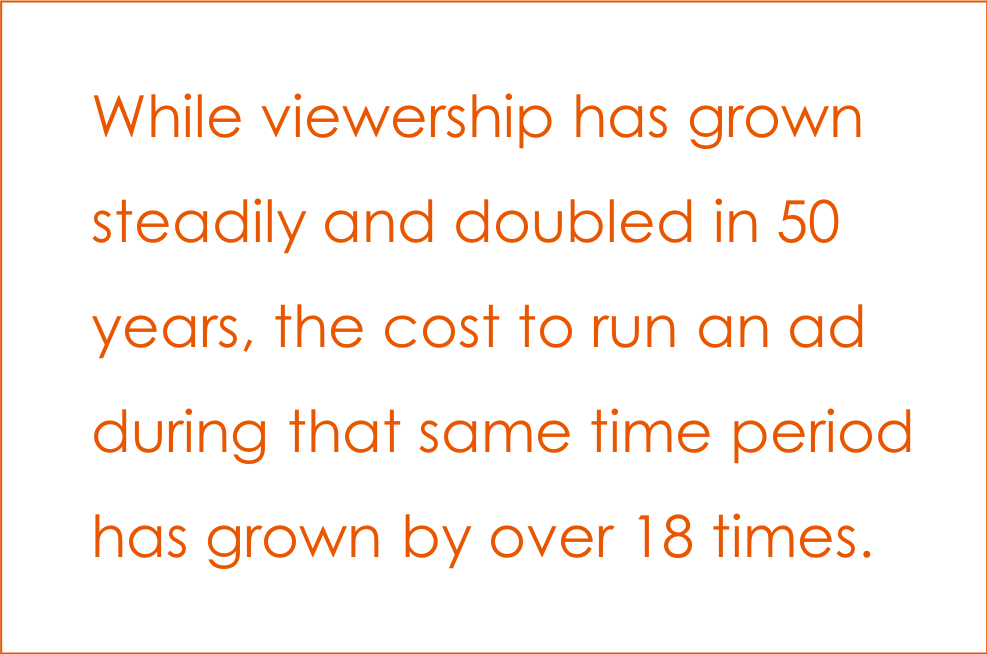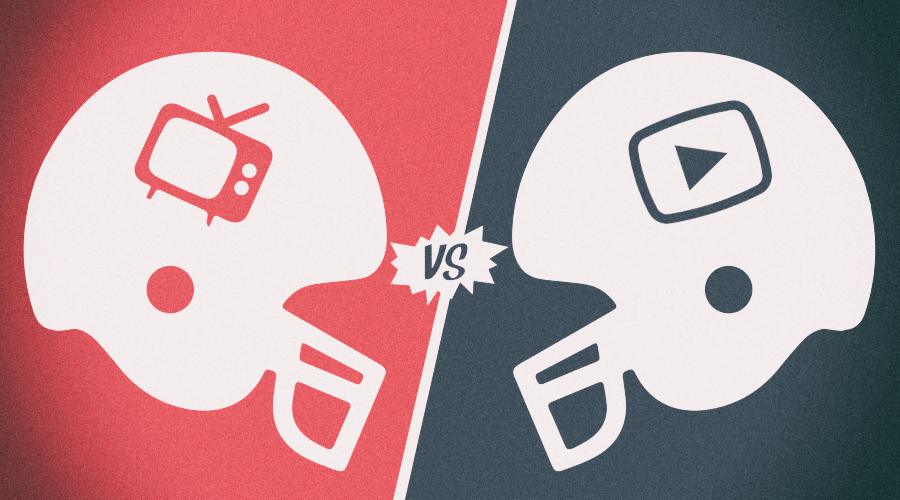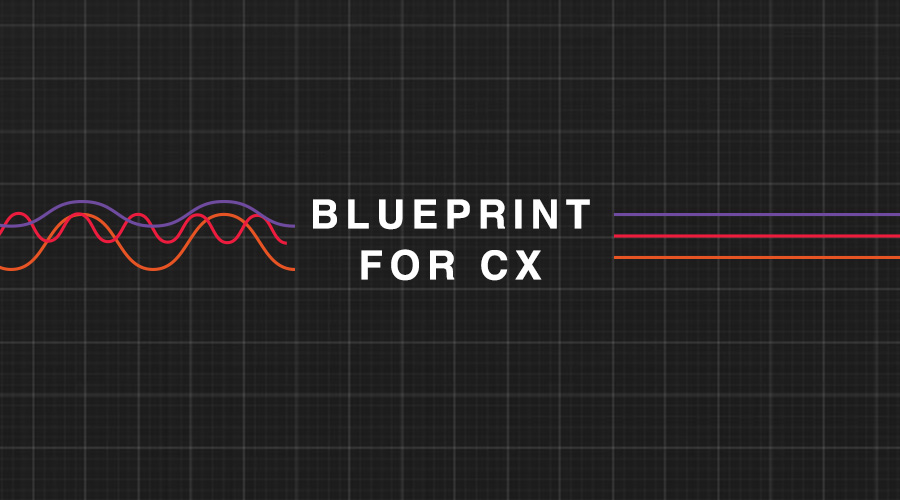The big game is almost here, so for sports fans it’s time to pick up that new big screen and start prepping your snacks. And if you’re a marketing and advertising geek, it’s time to prep the DVR so you can watch, re-watch and critique all of those ads.
After all, this is the…well, the Super Bowl of commercials.
If Super Bowl LIII is anything like its predecessors, the commercials airing between the on-field action of the Patriots and Rams will be some of the most expensive advertising to ever air on television. The average cost for just 30 seconds of air time during the game is expected to exceed $5 million, and the production cost for such a spot can easily cost an additional $1 million.
While having a commercial you worked on shown during the Super Bowl is probably the secret fantasy of many advertisers and marketers, with such high costs, it makes sense to ask, “Is this really worth it?” Well, the answer is… “It depends.”
Audience Growth vs. Ad Spend Growth

Since the first Super Bowl in 1967, the event has been an opportunity for networks to charge a premium for the millions of viewers that inevitably tune in every year. The first Super Bowl attracted over 51 million viewers and was the only game to be broadcast on more than one channel. Since then, the game has peaked at 114 million viewers in 2015 and remains relatively close to that amount. That’s quite an audience and it’s impressive to think that the game has grown to attract the attention of over one out of every three Americans since it began.
But Super Bowl advertising has grown on an entirely different scale. Advertisers, on average and adjusted for inflation, paid what seems now to be a paltry sum of only $300,000 to capture their 30 seconds of airtime in 1967. For Super Bowl LII in 2018, the average spot costs advertisers just over $5 million with projections for this year’s average to exceed $5.5 million.
While viewership has grown steadily and doubled in 50 years, the cost to run an ad during that same time period has grown by over 18 times what the original advertisers paid – keep in mind that is already adjusted for inflation.
The Search Impact
Getting back to the original question, does it make sense to spend $6.5 million to produce and air a 30-second spot for just over 100 million U.S. viewers?
It’s hard from the outside looking in to determine whether or not a specific company can directly attribute any sales back to a particular Super Bowl ad. But, to understand the impact, we can take a look at other more indirect methods of measurement, like the volume of people searching for a particular brand or product.
So, we used Google Trends data to look at the volume of searches for specific brand keywords before, during and after last year’s Super Bowl to see if there was any correlation between Super Bowl ad placement and the volume of searches conducted for that brand.
Some Interesting Results
Depending on what type of brand we’re talking about, it may very well make sense to invest in Super Bowl ads.
When we looked into the data, companies that sold small consumable items, like alcohol and snack food, seemed to have an immediate noticeable swing in search volume around the Super Bowl. Even Amazon’s Alexa voice service, which aired an ad where the platform’s voice was replaced by celebrities, saw a similar increase in traffic.
But the visibility of the big game didn’t translate equally for all brands. Automobile manufacturers, which typically maintain a strong presence throughout the game, saw almost no upswing in traffic as a result of their ads. After reviewing data from Hyundai, Kia, Toyota and Dodge, there was no noticeable bump in search volume. The only automotive brand that saw any benefit from their ad was Jeep, who had a somewhat memorable co-branded ad with the Jurassic Park movie franchise.
The Cost-Per-Thousand Angle
 Admittedly, Google Trend data doesn’t easily tell us the specific amount of search traffic that each brand saw as a result of their investment. But there is one more metric we can take a look at.
Admittedly, Google Trend data doesn’t easily tell us the specific amount of search traffic that each brand saw as a result of their investment. But there is one more metric we can take a look at.
If we take the total number of viewers by the total investment the average brand placed into their advertisement and converted it into a cost-per-thousand (CPM) metric, we can figure the average Super Bowl sponsor pays about $58.30 for every 1,000 viewers. To understand whether or not that’s a reasonable price, we also compared that cost to the typical CPM for an online video pre-roll ad during the same time period. This time, we found the cost to be about $10 CPM. So, for the same cost you would pay to reach 111 million people with a 30-second spot in the Super Bowl, you could reach 650 million people otherwise (or at the very least, have your ad seen that many times.)
The YouTube Connection
Now, to be fair to the Super Bowl, many of the game day ads also become popular earned media opportunities. That’s probably the case for the ads that see an upswing in search volume anyway. When we dug deeper into the types of search traffic, there was a small surge for nearly every advertiser on YouTube – even for the ads that didn’t see much attributable search volume on Google. As you can imagine, the ads that had noticeable search volume increases on Google directly had greater impact on YouTube as well, while those that saw little-to-no increase in traffic only saw a small increase in volume on YouTube.
So, the question still remains: Are Super Bowl ads worth it?
There is no question that putting an incredibly impactful ad in front of that audience in a format that allows everyone to talk about it around the water cooler the next day (and, hopefully, convinces them to buy your product) may, in fact, make it worth it.
In order to convert a consumer from ad to sale at a reasonable rate, companies need to be advertising something that anyone watching would want to buy – not an easy feat for 111 million people. But, if you don’t knock it out of the park (or put it right between the uprights, to keep this analogy relevant) then you might want to consider alternatives.
For most advertisers, $6.5 million is more than enough to create and execute several creative concepts to experiment with and find the right one. Once it performs, you still have plenty of investment to spend on video channels like television ads or digital video platforms.
In the end, it’s about knowing your audience. Because unless you are confident that everyone watching is, or can be, a customer AND you know that your ad will resonate with over 100 million people, then there are probably better ways to spend your money.
References:




